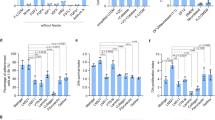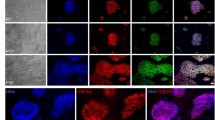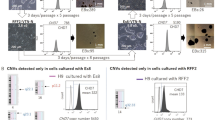Abstract
We re-examine the individual components for human embryonic stem cell (ESC) and induced pluripotent stem cell (iPSC) culture and formulate a cell culture system in which all protein reagents for liquid media, attachment surfaces and splitting are chemically defined. A major improvement is the lack of a serum albumin component, as variations in either animal- or human-sourced albumin batches have previously plagued human ESC and iPSC culture with inconsistencies. Using this new medium (E8) and vitronectin-coated surfaces, we demonstrate improved derivation efficiencies of vector-free human iPSCs with an episomal approach. This simplified E8 medium should facilitate both the research use and clinical applications of human ESCs and iPSCs and their derivatives, and should be applicable to other reprogramming methods.
This is a preview of subscription content, access via your institution
Access options
Subscribe to this journal
Receive 12 print issues and online access
$259.00 per year
only $21.58 per issue
Buy this article
- Purchase on Springer Link
- Instant access to full article PDF
Prices may be subject to local taxes which are calculated during checkout





Similar content being viewed by others
References
Thomson, J.A. et al. Embryonic stem cell lines derived from human blastocysts. Science 282, 1145–1147 (1998).
Reubinoff, B.E., Pera, M.F., Fong, C.Y., Trounson, A. & Bongso, A. Embryonic stem cell lines from human blastocysts: somatic differentiation in vitro. Nat. Biotechnol. 18, 399–404 (2000).
Yu, J. et al. Induced pluripotent stem cell lines derived from human somatic cells. Science 318, 1917–1920 (2007).
Takahashi, K. et al. Induction of pluripotent stem cells from adult human fibroblasts by defined factors. Cell 131, 861–872 (2007).
Park, I.H. et al. Reprogramming of human somatic cells to pluripotency with defined factors. Nature 451, 141–146 (2008).
Lowry, W.E. et al. Generation of human induced pluripotent stem cells from dermal fibroblasts. Proc. Natl. Acad. Sci. USA 105, 2883–2888 (2008).
Akopian, V. et al. Comparison of defined culture systems for feeder cell free propagation of human embryonic stem cells. In Vitro Cell. Dev. Biol. Anim. 46, 247–258 (2010).
Sun, N. et al. Feeder-free derivation of induced pluripotent stem cells from adult human adipose stem cells. Proc. Natl. Acad. Sci. USA 106, 15720–15725 (2009).
Skottman, H. & Hovatta, O. Culture conditions for human embryonic stem cells. Reproduction 132, 691–698 (2006).
Akopian, V. et al. Comparison of defined culture systems for feeder cell free propagation of human embryonic stem cells. In Vitro Cell Dev. Biol. Anim. 46, 247–258 (2010).
Garcia-Gonzalo, F.R. & Izpisua Belmonte, J.C. Albumin-associated lipids regulate human embryonic stem cell self-renewal. PLoS ONE 3, e1384 (2008).
Watanabe, K. et al. A ROCK inhibitor permits survival of dissociated human embryonic stem cells. Nat. Biotechnol. 25, 681–686 (2007).
Chen, G., Hou, Z., Gulbranson, D.R. & Thomson, J.A. Actin-myosin contractility is responsible for the reduced viability of dissociated human embryonic stem cells. Cell Stem Cell 7, 240–248 (2010).
Braam, S.R. et al. Recombinant vitronectin is a functionally defined substrate that supports human embryonic stem cell self-renewal via alphavbeta5 integrin. Stem Cells 26, 2257–2265 (2008).
Yu, J.Y. et al. Human induced pluripotent stem cells free of vector and transgene sequences. Science 324, 797–801 (2009).
Howden, S.E. et al. Chromatin-binding regions of EBNA1 protein facilitate the enhanced transfection of Epstein-Barr virus–based vectors. Hum. Gene Ther. 17, 833–844 (2006).
Assoian, R.K., Frolik, C.A., Roberts, A.B., Miller, D.M. & Sporn, M.B. Transforming growth factor-beta controls receptor levels for epidermal growth factor in NRK fibroblasts. Cell 36, 35–41 (1984).
Roberts, A.B. et al. Type beta transforming growth factor: a bifunctional regulator of cellular growth. Proc. Natl. Acad. Sci. USA 82, 119–123 (1985).
Lin, T. et al. A chemical platform for improved induction of human iPSCs. Nat. Methods 6, 805–808 (2009).
Liang, G., Taranova, O., Xia, K. & Zhang, Y. Butyrate promotes induced pluripotent stem cell generation. J. Biol. Chem. 285, 25516–25521 (2010).
Mali, P. et al. Butyrate greatly enhances derivation of human induced pluripotent stem cells by promoting epigenetic remodeling and the expression of pluripotency-associated genes. Stem Cells 28, 713–720 (2010).
Ware, C.B. et al. Histone deacetylase inhibition elicits an evolutionarily conserved self-renewal program in embryonic stem cells. Cell Stem Cell 4, 359–369 (2009).
Rothschild, M.A., Oratz, M. & Schreiber, S.S. Regulation of albumin metabolism. Annu. Rev. Med. 26, 91–104 (1975).
Oshima, R. Stimulation of the clonal growth and differentiation of feeder layer dependent mouse embryonal carcinoma cells by beta-mercaptoethanol. Differentiation 11, 149–155 (1978).
Martin, G.R. Isolation of a pluripotent cell line from early mouse embryos cultured in medium conditioned by teratocarcinoma stem cells. Proc. Natl. Acad. Sci. USA 78, 7634–7638 (1981).
Xu, Y. et al. Revealing a core signaling regulatory mechanism for pluripotent stem cell survival and self-renewal by small molecules. Proc. Natl. Acad. Sci. USA 107, 8129–8134 (2010).
Esteban, M.A. et al. Vitamin C enhances the generation of mouse and human induced pluripotent stem cells. Cell Stem Cell 6, 71–79 (2010).
Chung, T.L. et al. Vitamin C promotes widespread yet specific DNA demethylation of the epigenome in human embryonic stem cells. Stem Cells 28, 1848–1855 (2010).
Yu, J.Y. et al. Induced pluripotent stem cell lines derived from human somatic cells. Science 318, 1917–1920 (2007).
Seiffert, D. & Loskutoff, D.J. Evidence that type 1 plasminogen activator inhibitor binds to the somatomedin B domain of vitronectin. J. Biol. Chem. 266, 2824–2830 (1991).
Hayman, E.G., Pierschbacher, M.D., Ohgren, Y. & Ruoslahti, E. Serum spreading factor (vitronectin) is present at the cell surface and in tissues. Proc. Natl. Acad. Sci. USA 80, 4003–4007 (1983).
Ludwig, T.E. et al. Feeder-independent culture of human embryonic stem cells. Nat. Methods 3, 637–646 (2006).
Wojciechowski, K., Chang, C.H. & Hocking, D.C. Expression, production, and characterization of full-length vitronectin in Escherichia coli. Protein Expr. Purif. 36, 131–138 (2004).
Sengupta, S. et al. Highly consistent, fully representative mRNA-Seq libraries from ten nanograms of total RNA. Biotechniques 49, 898–904 (2010).
Li, B., Ruotti, V., Stewart, R.M., Thomson, J.A. & Dewey, C.N. RNA-Seq gene expression estimation with read mapping uncertainty. Bioinformatics 26, 493–500 (2010).
Acknowledgements
This work was supported by The Charlotte Geyer Foundation, the Morgridge Institute for Research, US National Institutes of Health grant UO1ES017166 (to J.A.T.) and National Institutes of Health contract RR-05-19 (to J.A.T.). We thank K. Eastman for editorial assistance, and C. Dewey, R. Stewart and A. Elwell for their assistance with gene expression analysis.
Author information
Authors and Affiliations
Contributions
G.C. and J.A.T. conceived the experiment; G.C., D.R.G., J.M.B., K.S.-O. and S.E.H. performed the reprogramming; Z.H., G.C. and N.E.P. produced vitronectin; G.C., D.R.G., J.M.B., N.R.D., G.O.L. and J.A.-B. performed the cell culture test; G.C., M.D.P. and R.W. derived fibroblasts; J.M.C.T. obtained the skin biopsy; V.R. and G.C. analyzed global expression; and G.C. and J.A.T. wrote the paper.
Corresponding author
Ethics declarations
Competing interests
J.A.T. is a founder, stockowner, consultant and board member of Cellular Dynamics International (CDI), and serves as scientific advisor to and has financial interests in Tactics II Stem Cell Ventures.
Supplementary information
Supplementary Text and Figures
Supplementary Figures 1–4 and Supplementary Tables 1–3 (PDF 6386 kb)
Rights and permissions
About this article
Cite this article
Chen, G., Gulbranson, D., Hou, Z. et al. Chemically defined conditions for human iPSC derivation and culture. Nat Methods 8, 424–429 (2011). https://doi.org/10.1038/nmeth.1593
Received:
Accepted:
Published:
Issue Date:
DOI: https://doi.org/10.1038/nmeth.1593
This article is cited by
-
Histone acetylation in an Alzheimer’s disease cell model promotes homeostatic amyloid-reducing pathways
Acta Neuropathologica Communications (2024)
-
Integration-free induced pluripotent stem cells from three endangered Southeast Asian non-human primate species
Scientific Reports (2024)
-
Comparison of Four Protocols for In Vitro Differentiation of Human Embryonic Stem Cells into Trophoblast Lineages by BMP4 and Dual Inhibition of Activin/Nodal and FGF2 Signaling
Reproductive Sciences (2024)
-
Human embryonic stem cells maintain their stemness in three-dimensional microenvironment
In Vitro Cellular & Developmental Biology - Animal (2024)
-
Development of synthetic modulator enabling long-term propagation and neurogenesis of human embryonic stem cell-derived neural progenitor cells
Biological Research (2023)



